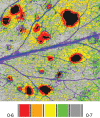Indirect suppression of photosynthesis on individual leaves by arthropod herbivory
- PMID: 18660492
- PMCID: PMC2707346
- DOI: 10.1093/aob/mcn127
Indirect suppression of photosynthesis on individual leaves by arthropod herbivory
Abstract
Background: Herbivory reduces leaf area, disrupts the function of leaves, and ultimately alters yield and productivity. Herbivore damage to foliage typically is assessed in the field by measuring the amount of leaf tissue removed and disrupted. This approach assumes the remaining tissues are unaltered, and plant photosynthesis and water balance function normally. However, recent application of thermal and fluorescent imaging technologies revealed that alterations to photosynthesis and transpiration propagate into remaining undamaged leaf tissue.
Scope and conclusions: This review briefly examines the indirect effects of herbivory on photosynthesis, measured by gas exchange or chlorophyll fluorescence, and identifies four mechanisms contributing to the indirect suppression of photosynthesis in remaining leaf tissues: severed vasculature, altered sink demand, defence-induced autotoxicity, and defence-induced down-regulation of photosynthesis. We review the chlorophyll fluorescence and thermal imaging techniques used to gather layers of spatial data and discuss methods for compiling these layers to achieve greater insight into mechanisms contributing to the indirect suppression of photosynthesis. We also elaborate on a few herbivore-induced gene-regulating mechanisms which modulate photosynthesis and discuss the difficult nature of measuring spatial heterogeneity when combining fluorescence imaging and gas exchange technology. Although few studies have characterized herbivore-induced indirect effects on photosynthesis at the leaf level, an emerging literature suggests that the loss of photosynthetic capacity following herbivory may be greater than direct loss of photosynthetic tissues. Depending on the damage guild, ignoring the indirect suppression of photosynthesis by arthropods and other organisms may lead to an underestimate of their physiological and ecological impacts.
Figures


Similar articles
-
Herbivory of wild Manduca sexta causes fast down-regulation of photosynthetic efficiency in Datura wrightii: an early signaling cascade visualized by chlorophyll fluorescence.Photosynth Res. 2012 Sep;113(1-3):249-60. doi: 10.1007/s11120-012-9741-x. Epub 2012 May 11. Photosynth Res. 2012. PMID: 22576017
-
Comparison of photosynthetic damage from arthropod herbivory and pathogen infection in understory hardwood saplings.Oecologia. 2006 Aug;149(2):221-32. doi: 10.1007/s00442-006-0444-x. Epub 2006 Jun 7. Oecologia. 2006. PMID: 16758220
-
Elevated CO2 interacts with herbivory to alter chlorophyll fluorescence and leaf temperature in Betula papyrifera and Populus tremuloides.Oecologia. 2012 Aug;169(4):905-13. doi: 10.1007/s00442-012-2261-8. Epub 2012 Feb 23. Oecologia. 2012. PMID: 22358995
-
Role of mesophyll diffusion conductance in constraining potential photosynthetic productivity in the field.J Exp Bot. 2009;60(8):2249-70. doi: 10.1093/jxb/erp036. Epub 2009 Apr 23. J Exp Bot. 2009. PMID: 19395391 Review.
-
Leaf hydraulics.Annu Rev Plant Biol. 2006;57:361-81. doi: 10.1146/annurev.arplant.56.032604.144141. Annu Rev Plant Biol. 2006. PMID: 16669766 Review.
Cited by
-
H2O2 Induces Association of RCA with the Thylakoid Membrane to Enhance Resistance of Oryza meyeriana to Xanthomonas oryzae pv. oryzae.Plants (Basel). 2019 Sep 16;8(9):351. doi: 10.3390/plants8090351. Plants (Basel). 2019. PMID: 31527548 Free PMC article.
-
Recent advances in plant early signaling in response to herbivory.Int J Mol Sci. 2011;12(6):3723-39. doi: 10.3390/ijms12063723. Epub 2011 Jun 7. Int J Mol Sci. 2011. PMID: 21747702 Free PMC article. Review.
-
Evaluation of the Morphological, Physiological and Biochemical Effects Induced by Coragen 20 SC in Some Non-Target Species.Toxics. 2023 Jul 17;11(7):618. doi: 10.3390/toxics11070618. Toxics. 2023. PMID: 37505583 Free PMC article.
-
Changes in oak (Quercus robur) photosynthesis after winter moth (Operophtera brumata) herbivory are not explained by changes in chemical or structural leaf traits.PLoS One. 2020 Jan 24;15(1):e0228157. doi: 10.1371/journal.pone.0228157. eCollection 2020. PLoS One. 2020. PMID: 31978155 Free PMC article.
-
Silencing the alarm: an insect salivary enzyme closes plant stomata and inhibits volatile release.New Phytol. 2021 Apr;230(2):793-803. doi: 10.1111/nph.17214. Epub 2021 Feb 16. New Phytol. 2021. PMID: 33459359 Free PMC article.
References
-
- Aldea M, Hamilton JG, Resti JP, Zangerl AR, Berenbaum MR, DeLucia EH. Indirect effects of insect herbivory on leaf gas exchange in soybean. Plant, Cell & Environment. 2005;28:402–411.
-
- Aldea M, Frank TD, DeLucia EH. A method for quantitative analysis of spatially variable physiological processes across leaf surfaces. Photosynthesis Research. 2006;a 90:161–172. - PubMed
-
- Aldea M, Hamilton JG, Resti JP, Zangerl AR, Berenbaum MR, Frank TD, et al. Comparison of photosynthetic damage from arthropod herbivory and pathogen infection in understory hardwood samplings. Oecologia. 2006;b 149:221–232. - PubMed

